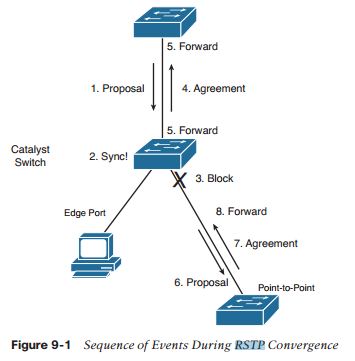CCNP Switch FAQ: Advanced Spanning Tree Protocoly
Q1. Which one of the following commands enables the use of RSTP?
a. spanning-tree mode rapid-pvst
b. no spanning-tree mode pvst
c. spanning-tree rstp
d. spanning-tree mode rstp
e. None. RSTP is enabled by default.
Q2. On which standard is RSTP based?
a. 802.1Q
b. 802.1D
c. 802.1w
d. 802.1s
Q3. Which of the following is not a port state in RSTP?
a. Listening
b. Learning
c. Discarding
d. Forwarding
Q4. When a switch running RSTP receives an 802.1D BPDU, what happens?
a. The BPDU is discarded or dropped.
b. An ICMP message is returned.
c. The switch begins to use 802.1D rules on that port.
d. The switch disables RSTP.
Q5. When does an RSTP switch consider a neighbor to be down?
a. After three BPDUs are missed
b. After six BPDUs are missed
c. After the Max Age timer expires
d. After the Forward timer expires
Q6. Which process is used during RSTP convergence?
a. BPDU propagation
b. Synchronization
c. Forward timer expiration
d. BPDU
Q7. What causes RSTP to view a port as a point-to-point port?
a. Port speed
b. Port media
c. Port duplex
d. Port priority
Q8. Which of the following events triggers a topology change with RSTP on a nonedge port?
a. A port comes up or goes down.
b. A port comes up.
c. A port goes down.
d. A port moves to the Forwarding state.
Q9. Which of the following isnot a characteristic of MST?
a. A reduced number of STP instances
b. Fast STP convergence
c. Eliminated need for CST
d. Interoperability with PVST+
Q10. Which of the following standards defines the MST protocol?
a. 802.1Q
b. 802.1D
c. 802.1w
d. 802.1s
Q11. How many instances of STP are supported in the Cisco implementation of MST?
a. 1
b. 16
c. 256
d. 4096
Q12. What switch command can be used to change from PVST+ to MST?
a. spanning-tree mst enable
b. no spanning-tree pvst+
c. spanning-tree mode mst
d. spanning-tree mst
More Resources
